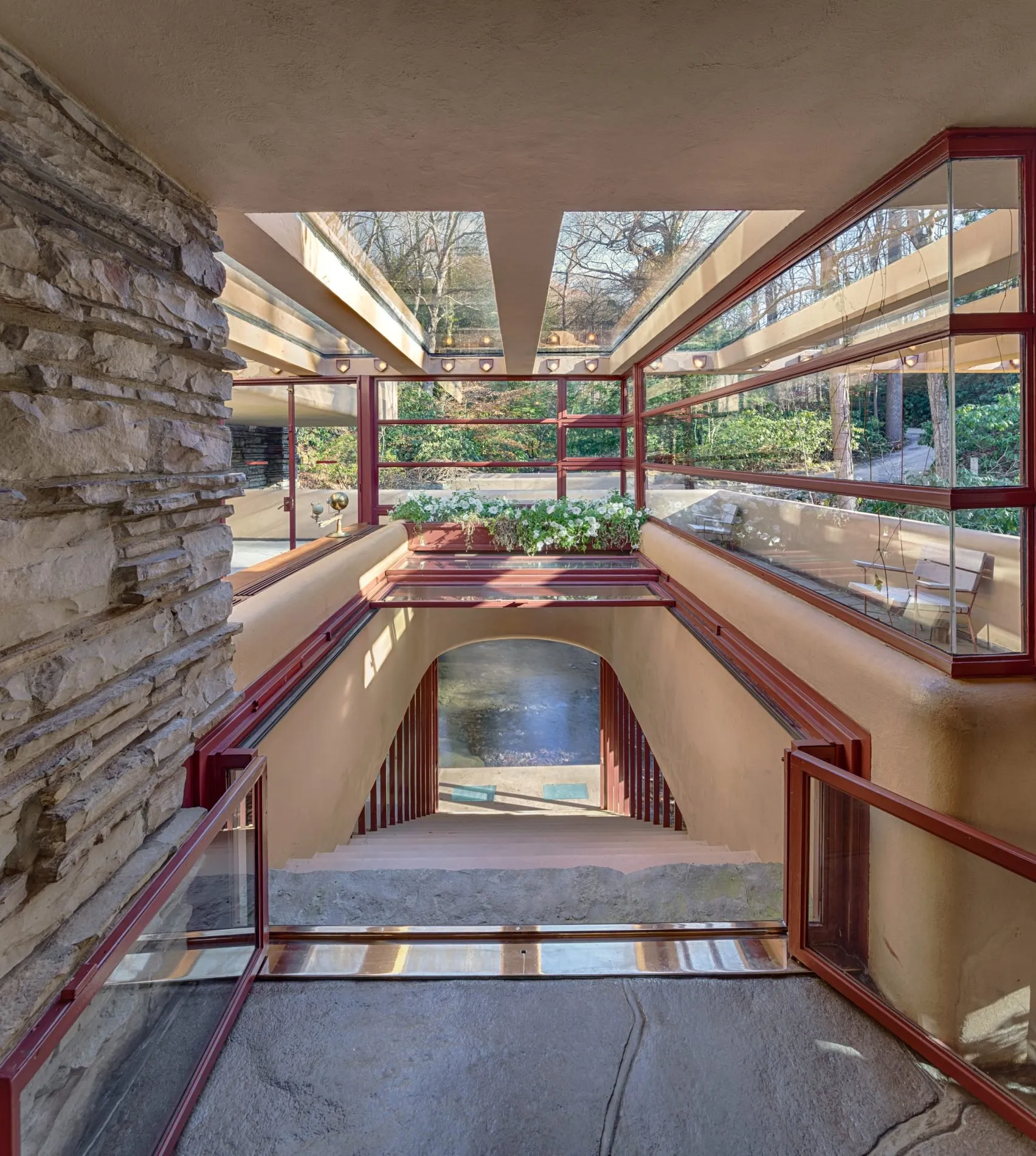Frank Lloyd Wright’s architectural genius extended far beyond striking exteriors. He envisioned homes as complete works of art, where interior spaces seamlessly integrated with the architecture and the surrounding environment. Wright’s interior design principles, characterized by organic architecture, a minimalist aesthetic, and a deep reverence for nature, continue to inspire and captivate, proving their timelessness decade after decade.
Frank Lloyd Wright Interior Design
Stepping into a Frank Lloyd Wright interior is akin to entering a symphony of nature and human design. Imagine warm sunlight cascading through expansive windows, illuminating a space adorned with the raw beauty of natural materials like wood and stone. This harmonious blend of light, materials, and open space is a hallmark of Wright’s vision, where nature isn’t just a backdrop but an integral element woven into the very fabric of the home.
Wright’s innovative approach to space redefined traditional home design. He rejected the confines of compartmentalized rooms, instead pioneering open floor plans that fostered a sense of flow and connection. This design philosophy extended to his choice of furnishings. Built-in seating, shelves, and tables served both functional and aesthetic purposes, their clean lines and minimalist forms blending seamlessly with the overall design.
While Wright championed simplicity, his interiors were far from austere. He recognized the power of art to elevate a space, often incorporating murals and carefully chosen décor as accents that infused personality and a unique visual narrative. This interplay of art and architecture created a cohesive and captivating environment, transforming homes into immersive experiences.
What Defined Frank Lloyd Wright Interior Design Style?
Frank Lloyd Wright’s interior design philosophy, deeply rooted in his concept of “organic architecture,” transcended mere aesthetics. He envisioned structures that existed in harmony with their surroundings, blurring the lines between the built environment and the natural world. This philosophy manifested in homes that felt like extensions of the landscape, where every detail, from the materials used to the placement of windows, aimed to connect inhabitants to the beauty of the outdoors.
Functionality was just as important as form in Wright’s designs. His disdain for clutter was palpable; every piece of furniture, every fixture had a purpose. This emphasis on utility led him to champion built-in storage solutions, multipurpose furniture, and open floor plans that maximized space and natural light. This approach not only enhanced the home’s practicality but also contributed to its clean, uncluttered aesthetic—a principle that resonates strongly with contemporary minimalist design trends.
Wright’s artistic sensibilities were evident in every aspect of his interiors. He understood that true beauty resided in the cohesion of elements, designing furniture, lighting, textiles, and even carpets to complement the home’s overall aesthetic. This comprehensive approach resulted in visually unified and harmonious spaces where every detail, from a door handle to a stained-glass window, contributed to a singular artistic expression.
Key Characteristics of Frank Lloyd Wright’s Interior Design:
| Feature | Description |
|---|---|
| Organic Design | Harmony between indoors and outdoors, using wood, stone, and glass to echo the natural world. |
| Practical Beauty | Open spaces, custom-built furniture, and minimal clutter for functionality and aesthetic appeal. |
| Artful Living | Every element, from furniture to lighting, meticulously designed to complement the home’s style, creating a cohesive and artistic environment. |
Wright’s legacy extends far beyond the buildings he designed. He redefined the very concept of interior space, demonstrating that functionality and beauty could coexist in perfect harmony. His timeless principles continue to influence and inspire architects and designers today, solidifying his place as a true visionary in the world of design.
Want to learn more? Check out this link!
Exploring the Principles of Frank Lloyd Wright Interiors: Organic Architecture and Beyond
Frank Lloyd Wright’s impact on architecture and design remains undeniable, largely due to his groundbreaking concept of organic architecture. This philosophy, which permeated both his exterior and interior designs, championed a harmonious relationship between buildings and their natural surroundings. It’s an approach that transcends mere aesthetics, advocating for a design ethos that respects and integrates nature, resulting in spaces that feel balanced, serene, and connected to the world around them.
Organic Architecture’s Enduring Legacy
Instead of viewing buildings as separate entities imposed upon the landscape, Wright envisioned structures that existed in concert with nature. Organic architecture emphasized using materials, forms, and design principles that complemented the surrounding environment. This approach led to homes that seemed to emerge organically from the land, their designs echoing the curves of a hillside or embracing the presence of a mature tree. Wright’s legacy is evident in the growing trend of biophilic design, which incorporates natural elements into modern buildings to improve well-being and create healthier living spaces.
Integration with Nature
Central to Wright’s organic design philosophy was the desire to blur the boundaries between indoor and outdoor spaces. Expansive windows, often stretching from floor to ceiling, weren’t merely architectural features but carefully considered portals that invited nature inside. These large panes of glass framed breathtaking views, allowing natural light to flood interiors and creating a sense of being immersed in nature while remaining comfortably sheltered.
If you are in need of an interior door design, make sure you choose a material that will meet your needs and a style that will complement your home.
Respect for Topography
While some architects impose their designs onto a site, Wright believed in working with the land’s natural contours. He carefully considered topography, integrating a building’s design into the existing slopes, hills, and valleys. This approach not only minimized the environmental impact but also resulted in structures that felt innately connected to their surroundings, their forms appearing as natural extensions of the landscape.
Blurring Indoor-Outdoor Boundaries
Wright’s intention to create a seamless transition between indoor and outdoor spaces extended beyond expansive windows. He incorporated terraces, patios, and balconies that flowed naturally from interior rooms, further dissolving the division between the built and natural environments. These outdoor living spaces became integral parts of the home, encouraging residents to connect with nature and enjoy the benefits of fresh air and sunlight.
Visiting churches can inspire you to consider the church building interior design for your own home.
Sustainability and Harmony
Long before sustainability became a mainstream concern, Wright’s organic architecture principles inherently embraced ecological responsibility. By designing structures in harmony with nature, utilizing natural light, ventilation, and local materials, he minimized the environmental impact of his buildings. This forward-thinking approach serves as a timeless example of how design can be both aesthetically pleasing and environmentally conscious.
Key Takeaways:
- Organic architecture promotes a harmonious relationship between buildings and their natural surroundings.
- Wright’s designs emphasized respect for the land and its features, integrating structures into the existing topography.
- He sought to eliminate the barrier between indoors and outdoors, creating a seamless flow between these spaces.
- Wright’s organic architecture principles naturally embraced sustainability, minimizing environmental impact by utilizing natural resources and local materials.
Citation:
Frank Lloyd Wright’s Organic Architecture.
How-To: Incorporating Frank Lloyd Wright Design Elements In Your Home
Translating Frank Lloyd Wright’s iconic style into a contemporary home is achievable, even without embarking on a complete architectural overhaul. By understanding the essence of his design principles and incorporating key elements, you can infuse your living spaces with the timeless elegance and organic harmony that mark his work.
Think Like Frank: Key Ideas
Before diving into specific design choices, it’s crucial to grasp the fundamental principles that guided Wright’s vision:
- Openness: Prioritize a sense of spaciousness and flow by removing unnecessary walls to create open floor plans. This design choice maximizes natural light and visually connects living spaces, mimicking the feeling of being connected to the surrounding landscape.
- Natural Vibes: Emphasize natural materials such as wood, stone, and leather in your furniture, flooring, and décor. These materials not only bring the beauty of the outdoors in but also add warmth and texture, creating a sense of groundedness and tranquility.
- Less is More: Embrace a minimalist mindset when selecting furniture and decorative items. Opt for pieces with clean lines and simple forms, prioritizing functionality and avoiding unnecessary ornamentation. This allows the beauty of the architecture and natural materials to take center stage.
- Shapes Tell a Story: Incorporate geometric patterns and designs inspired by nature into your décor. Think about using textiles with repeating geometric motifs, incorporating furniture with strong lines, or adding accents that feature stylized natural forms, adding visual interest and subtle dynamism to your space.
- Art is Personal: Infuse your personality into the space. Don’t be afraid to display artwork, family heirlooms, or travel souvenirs that speak to you. These personal touches make a house a home, adding character and warmth that generic design trends can’t replicate.
Bringing the Outdoors In
- Nature’s Palette: When choosing paint colors, furniture fabrics, or decorative accents, let your surrounding landscape be your guide. Are you surrounded by lush greenery? Earthy browns? Reflect these colors in your design choices to create a harmonious connection between your interior and the outdoors.
- Windows Are Your Friend: Maximize natural light by incorporating large windows, or consider adding skylights to brighten up darker areas. If privacy is a concern, opt for sheer curtains or blinds that diffuse light while maintaining a connection to the outside world.
- Materials Matter: Whenever possible, choose natural materials over synthetic alternatives. A solid wood dining table, a stone fireplace surround, or even a simple vase filled with branches can introduce an organic element that grounds the space and enhances its connection to nature.
Minimalism: Function Meets Style
- Declutter Your Life: A cluttered environment detracts from the beauty of a well-designed space. Take time to declutter regularly, donating or discarding items that no longer serve a purpose. This ongoing practice helps maintain a sense of calm and order, allowing the design elements to shine.
- Open It Up: If you’re considering a renovation, consult with a professional about the possibility of removing non-load-bearing walls to create a more open floor plan. This can dramatically enhance the flow of natural light and create a greater sense of spaciousness.
- Customize It: Whenever possible, opt for custom-built furniture and storage solutions. Built-in bookshelves, window seats, or even a dining table designed specifically for your space not only maximize functionality but also add a level of tailored sophistication that elevates the entire room.
If you are a salon owner then you know how important the right salon interior design is for your business to succeed.
Art and Architecture in Perfect Harmony
- Geometric Fun: Integrate geometric patterns and natural motifs into your décor. Consider throw pillows with geometric designs, area rugs with stylized floral patterns, or even artwork featuring strong, clean lines. These subtle touches add visual interest without overwhelming the space.
- Your Personal Touch: A home should reflect those who live in it. Display artwork you love, family heirlooms that hold special meaning, or unique souvenirs from your travels. These personal touches infuse your home with character, warmth, and a sense of history.
- Built-in Brilliance: Built-in features are both practical and aesthetically pleasing. Consider integrating built-in bookshelves, window seats with storage compartments, or even a custom entertainment center. These elements save space, reduce clutter, and often become design focal points within a room.
By incorporating these elements and embracing the spirit of Frank Lloyd Wright’s design principles, you can transform your home into a haven of timeless elegance and organic harmony. Remember, the key is not to replicate his style literally but to capture its essence and adapt it to your own personal aesthetic and needs.
- Ceramic Kitchen Wall Tiles: Style and Protection for Your Walls - December 17, 2025
- Kitchen tiling wall: Elevate your kitchen with stylish wall tiles - December 16, 2025
- Gray Kitchen Backsplash Tile: Ideas for a Stylish Upgrade - December 14, 2025









